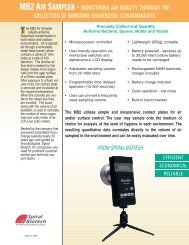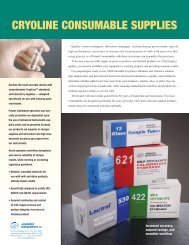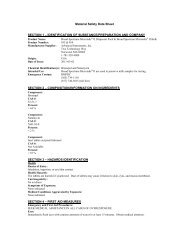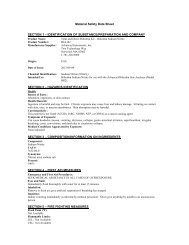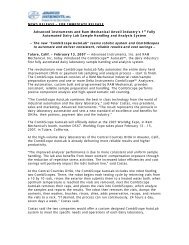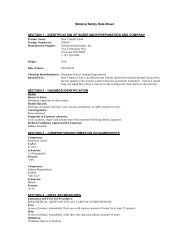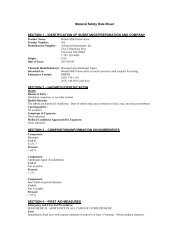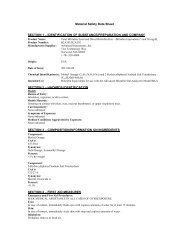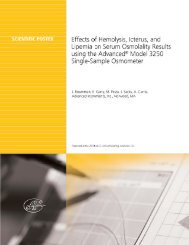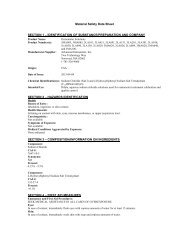Material Safety Data Sheet - Advanced Instruments, Inc.
Material Safety Data Sheet - Advanced Instruments, Inc.
Material Safety Data Sheet - Advanced Instruments, Inc.
You also want an ePaper? Increase the reach of your titles
YUMPU automatically turns print PDFs into web optimized ePapers that Google loves.
<strong>Material</strong> <strong>Safety</strong> <strong>Data</strong> <strong>Sheet</strong><br />
SECTION 1 – IDENTIFICATION OF SUBSTANCE/PREPARATION AND COMPANY<br />
Product Name:<br />
Brotab Milk Preservative<br />
Product Number: 955<br />
Manufacturer/Supplier: <strong>Advanced</strong> <strong>Instruments</strong>, <strong>Inc</strong>.<br />
Two Technology Way<br />
Norwood, MA 02062<br />
1-781-320-9000<br />
Origin:<br />
USA<br />
Date of Issue: 2011-05-02<br />
Chemical Identification(s): Bronopol and Antifungal Agent<br />
Intended Use:<br />
Brotab Milk Preservative is used to preserve milk samples for testing.<br />
Emergency Contact: RMPDC<br />
(303) 739-1110<br />
(877) 740-5015 (toll free)<br />
SECTION 2 – COMPOSITION/INFORMATION ON INGREDIENTS<br />
Component:<br />
Bronopol<br />
CAS #:<br />
52-51-7<br />
Percent:<br />
< 44 %<br />
Component:<br />
Antifungal Agent (Confidential)<br />
CAS #:<br />
Not available<br />
Percent:<br />
< 2 %<br />
Component:<br />
Inert tablet excipient/lubricant<br />
CAS #:<br />
Not Available<br />
Percent:<br />
< 55 %<br />
SECTION 3 – HAZARDS IDENTIFICATION<br />
Health<br />
Routes of Entry:<br />
Inhalation, ingestion, or eye/skin contact.<br />
Health Hazards:<br />
The tablets are harmful if swallowed. Dust of tablets may cause irritation to skin, eyes, and mucus membrane.<br />
Carcinogenicity:<br />
No evidence<br />
Symptoms of Exposure:<br />
None indicated<br />
Medical Conditions Aggravated by Exposure:<br />
None indicated<br />
SECTION 4 – FIRST AID MEASURES<br />
Emergency and First Aid Procedures:<br />
SEEK MEDICAL ASSISTANCE IN ALL CASES OF OVEREXPOSURE.<br />
Eyes:<br />
Immediately flush eyes with copious amounts of water for at least 15 minutes. Obtain medical attention.
Page 2 of 4<br />
Skin:<br />
Immediately drench with water. Remove contaminated clothing. Swab affected area with water and soap and water.<br />
Obtain medical attention.<br />
Inhalation:<br />
Remove to fresh air. Keep warm and at rest. Obtain urgent medical attention.<br />
Ingestion:<br />
Wash out mouth thoroughly with water and give sips of water to drink. Obtain medical attention.<br />
SECTION 5 – FIRE FIGHTING MEASURES<br />
Flash Point (ºF):<br />
No data available<br />
Flammable Limits:<br />
LEL: No data available<br />
UEL: No data available<br />
Extinguishing Media:<br />
Use water spray, alcohol-resistant foam, dry chemical or carbon dioxide.<br />
Fire Fighting Procedures:<br />
Wear self contained breathing apparatus for firefighting if in confined space.<br />
Fire and Explosion Hazards:<br />
Not flammable or explosive. Product does not ignite when exposed to open flame.<br />
SECTION 6 – ACCIDENTAL RELEASE MEASURES<br />
Spill Response:<br />
Wear respiratory protection, rubber gloves, and chemical safety goggles. Prevent entry into watercourses.<br />
Immediately sweep up or vacuum (avoiding dust) and remove spillage to a polythene lined container for correct<br />
disposal. Clean the spillage site with detergent and water and retain washings for correct disposal. Clean up and place<br />
in closed container for proper disposal as described under, Section 13, Disposal Considerations. Comply with local,<br />
state, and country regulations on reporting releases. Refer to Section 15, Regulatory Information, for regulatory data.<br />
SECTION 7 – HANDLING AND STORAGE<br />
Keep container tightly closed. Do not get in eyes, on skin, or on clothing. Ensure good ventilation/exhaustion at the<br />
workplace. Store away from oxidizing agents and/or bases, heat or sources of ignition and food, drink, or animal feed.<br />
SECTION 8 – EXPOSURE CONTROLS/PERSONAL PROTECTION<br />
Occupational Exposure Limits:<br />
Bronopol: In-house exposure level of 0.5 mg/m 3 has been established.<br />
Natamycin: In-house exposure level of 0.1 mg/m 3 has been established.<br />
Ventilation, Respiratory Protection, Protective Clothing, Eye Protection:<br />
Adequate ventilation is required. Protective gloves must be worn to prevent skin contact (Neoprene or equivalent).<br />
<strong>Safety</strong> glasses with side shields must be worn at all times.<br />
Work/Hygienic Practices:<br />
Wash hands thoroughly after handling. Do not take internally. Eyewash and safety equipment should be readily<br />
available.<br />
SECTION 9 – PHYSICAL AND CHEMICAL PROPERTIES<br />
Appearance:<br />
Yellow-orange tablets<br />
Boiling Point:<br />
No data available<br />
Specific Gravity (H 2 O = 1):<br />
No data available<br />
Explosiveness (ºC):<br />
140°C<br />
pH:<br />
5 to 7 (1% w/v solution of Bronopol @ 20°C)<br />
Evaporation Rate (BuAc = 1):<br />
No data available
Page 3 of 4<br />
Vapor Pressure (mm Hg):<br />
No data available<br />
Vapor Density (AIR = 1):<br />
No data available<br />
Volatility:<br />
No data available<br />
Solubility in Water (%):<br />
Soluble<br />
SECTION 10 – STABILITY AND REACTIVITY<br />
Stability:<br />
Stable under normal temperatures and pressures<br />
Conditions to Avoid:<br />
Heat and sources of ignition<br />
<strong>Material</strong>s to Avoid:<br />
Oxidizing agents and/or bases; metals (especially aluminum)<br />
Hazardous Decomposition:<br />
Oxides of nitrogen and hydrogen bromide<br />
SECTION 11 – TOXICOLOGICAL INFORMATION<br />
For Homidium Bromide<br />
Symptoms of Exposure:<br />
Irritating on contact with skin, eyes, mucous membranes, or upper respiratory tract. Harmful if swallowed.<br />
Medical Conditions Aggravated by Exposure:<br />
None indicated.<br />
Routes of Entry:<br />
Inhalation, ingestion, or skin contact<br />
Carcinogenicity:<br />
None indicated<br />
Toxicity <strong>Data</strong>:<br />
LD50 Oral Rat – 307/342 mg/kg (male/female)<br />
LC50 Dermal Rat – 1600 mg/kg<br />
Toxicological Findings:<br />
Weak or negative sensitization response in guinea pig maximization tests. Irritant to skin and eyes of rabbit. No<br />
evidence of carcinogenicity in oral and dermal rat studies. Not mutagenic, teratogenic or toxic to reproductive organs.<br />
SECTION 12 – ECOLOGICAL INFORMATION<br />
Ecological effects:<br />
None indicated<br />
SECTION 13 – DISPOSAL CONSIDERATIONS<br />
EPA Waste Numbers:<br />
Not available<br />
Treatment:<br />
Dispose of in accordance with current legislation. Contaminated empty packaging materials should be treated in a<br />
similar manner. ALWAYS CONTACT A PERMITTED WASTE DISPOSAL SITE (TSD) TO ASSURE<br />
COMPLIANCE WITH ALL CURRENT LOCAL, STATE, AND COUNTRY REGULATIONS.<br />
SECTION 14 – TRANSPORTATION INFORMATION<br />
DOT Proper Shipping Name:<br />
Not restricted<br />
DOT ID Number:<br />
Not restricted<br />
SECTION 15 – REGULATORY INFORMATION<br />
European Information:<br />
Not available
Page 4 of 4<br />
Reviews, Standards, and Regulations:<br />
Not available<br />
SECTION 16 – OTHER INFORMATION<br />
Comments:<br />
None<br />
NFPA Hazard Ratings:<br />
Health: 3<br />
Flammability: 1<br />
Reactivity: 0<br />
Special Hazards: Not available<br />
<strong>Advanced</strong> <strong>Instruments</strong>, <strong>Inc</strong>. provides the information contained herein in good faith, but makes no representation as to its<br />
comprehensiveness or accuracy. This document is intended only as a guide. Individuals receiving this information must exercise their<br />
independent judgment in determining its appropriateness for a particular purpose. <strong>Advanced</strong> <strong>Instruments</strong> will not be responsible for<br />
damages resulting from use of or reliance upon this information.<br />
MSD050 Rev 0 (May 2011)




